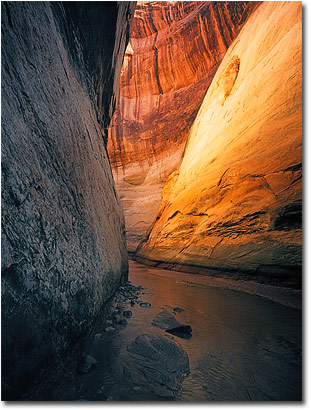Large Format and Personal StyleText and photography copyright Guy Tal. All rights reserved.
Return to Nature Photography 101 Index
“Every photographer has a definable style, but I spent at least a decade worrying that I didn’t.” – Galen Rowell
A mantra you will often see repeated in photographic discussion forums is that one should pursue developing a “personal style” and that those who have reached such panacea are to be envied and revered. Similarly many will argue for the art of seeing – visualization, working with light, composing, creating, expressing an inner vision, the mind’s eye, etc. These discussions often follow questions about gear and technique, vigorously stressing that gear is not important, it’s the style or light or composition that makes an image great. Make sense? Well, yes, but not entirely.
We are each a product of different circumstances, be they life experiences, genetics, personal beliefs and preferences – you name it. Humans are complex beings. I therefore believe that each and every one of us is already endowed with a personal style that is unique and distinctive, whether it’s a complete departure from any norm or whether it manifests itself in subtle nuances. The challenge then is not to find your style, but rather to express it – to learn how to let go of the safety in following conventions, to tune out all voices but your inner one. Embrace your individuality, and you are there!

|
What does any of this have to do with Large Format you ask? Well – for many it seems that the adoption of the slow and meticulous process involved with using a view camera has played a major role in their ability to express their unique style. I have heard any number of people state they have become more creative when slowed down, more attuned to composition while under a dark cloth, more likely to get a “keeper” when faced with the cost and effort of producing a Large Format image. So – how can anyone claim that equipment does not matter in the face of so much empirical evidence to the contrary?
You’ll have to forgive me for being provocative. I’m sure the previous paragraph stirred some reaction (which I imagine is different depending on whether you are a user of any given format). I do not presume to know the answer, but I’ll throw in my personal opinion for what it’s worth. After all I should know something about it - I am a poster-child for the phenomenon described above. Looking back, I have indeed become more successful in expressing my vision with every increase in camera format that I adopted. Then again – I knew I would. How? Because I truly believed I would.
Let me explain. In reality it was not the format, or the forces at play (the slow process, the dark cloth, the expensive film, the romantic perception of using a view camera in the field etc.). I became more successful because I was challenged and because I convinced myself of the inevitability of the improvement. I believed the new camera and process would make me a better photographer and I was determined to make it work. It was that determination that made it happen - I tried harder, became a harsher critic or my own work, spent more time in the field, and agonized more over my failures. What did this have to do with my equipment? Nothing! It was all in my head.
Surely you’ve heard of self-fulfilling prophecies. In my case this was the overriding theme. I truly believed the larger formats would make me a better photographer, and they did – because I believed they would. If I believed I could become a better photographer by eating raw Habanero peppers – the effect would likely have been the same.
For a long time now I owned a book by Galen Rowell titled “Mountain Light” that I keep revisiting from time to time. With every read I am amazed to discover how much knowledge was always at my fingertips that I did not fully digest. Perhaps there’s an inevitable progression one must follow before they are ready to learn these lessons. I recently came back to this paragraph:
“(…) A more common situation, one that confronts every 35mm photographer, is to come across a scene that looks as if it would be splendid using a large-format camera, but only so-so on a 35mm slide. This is exactly the kind of situation where differences in approach between large- and small-format photographers matter more than their equipment. A large-format photographer would stop at such a scene, consider it for a while, then spend long minutes setting up his camera until the scene was framed exactly the way he wanted it. A typical amateur with a 35mm would stop, turn towards the scene, make a handheld exposure or two within the first minute, and leave. (…) When I come across a still landscape that moves me, I pretend my Nikon is a bigger camera.”
The conclusion is simple – it’s not the camera that defines your style. It’s all in your head! The large camera may give you better resolution, more detail, larger prints, optical effects only possible using camera movements, the joy of reviewing a large piece of film on a light table, and many other advantages (as well as disadvantages), and while it may help you express your own personal style – it will not help you define it. It is already defined by virtue of who you are. Learn to listen to its voice within you. Learn to let go.
GT-NPN 0440
Comments on NPN large format nature photography articles? Send them to the editor.
Guy Tal resides in Utah, where most of the Colorado Plateau's breathtaking grandeur can be found, and where issues of preservation and land-use are among the most prominent on the political agenda. Guy's large format photography can be viewed on his website at http://scenicwild.com.


| 


